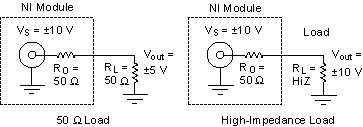Output Impedance
NI signal generators have an output impedance of 50 Ω and an optional 75 Ω on select devices.
If the load impedance matches the output impedance, the voltage at the signal output connector is at the needed level. The voltage at the signal output connector varies with load output impedance, up to doubling the voltage for a high impedance load, as shown in the following figure.

In the previous figure, the required output voltage is ±5 V. The NI signal generator internal voltage source generates twice this voltage, ±10 V, expecting the voltage to be halved due to the voltage divider formed by RO and RL. The relationship between the output voltage and the load can be calculated as follows:
Vout = [RL/(RL + RO)] × [VS]
| where | |
| Vout = the voltage level delivered to RL | |
| RL = the load impedance in ohms | |
| RO = the output impedance on the NI signal generator | |
| VS = the voltage level generated by the source previous to RO | |
By default, RO = 50 Ω, but you can use NI-FGEN to set it to 75 Ω on select devices. Also, with some devices you can enter the value of RL, and the device changes VS accordingly to deliver the requested Vout.